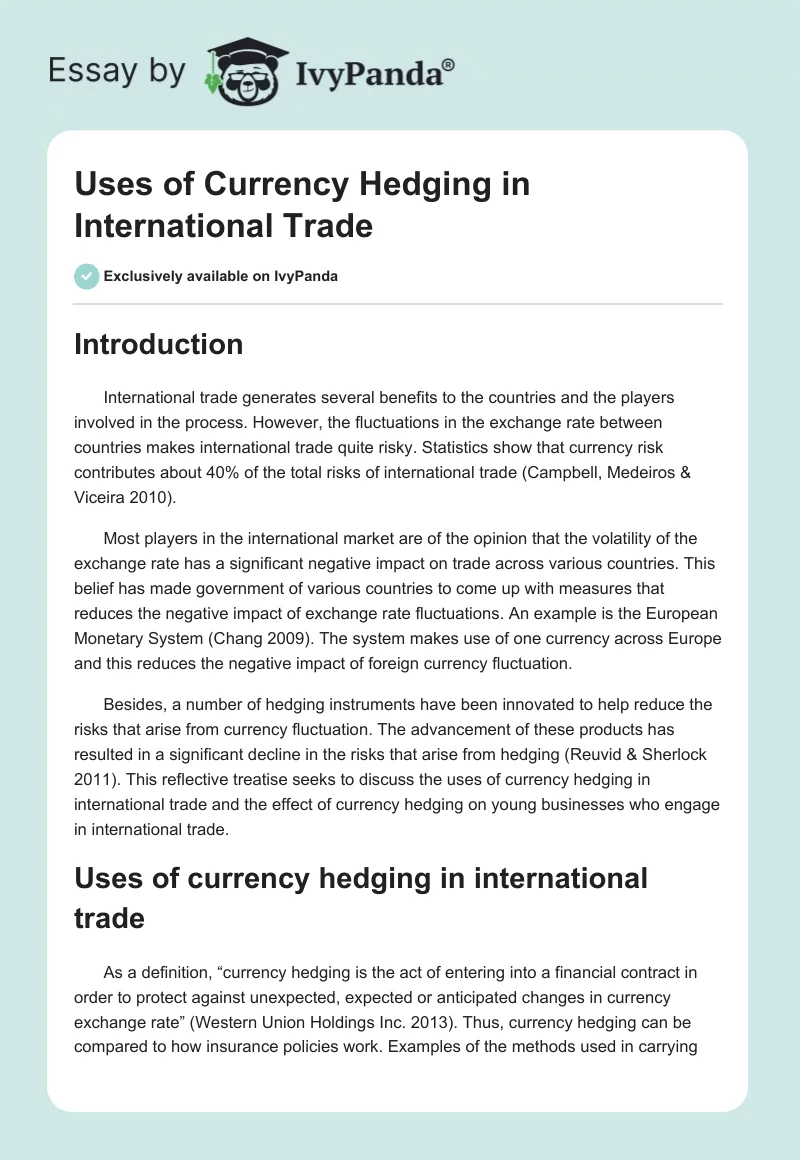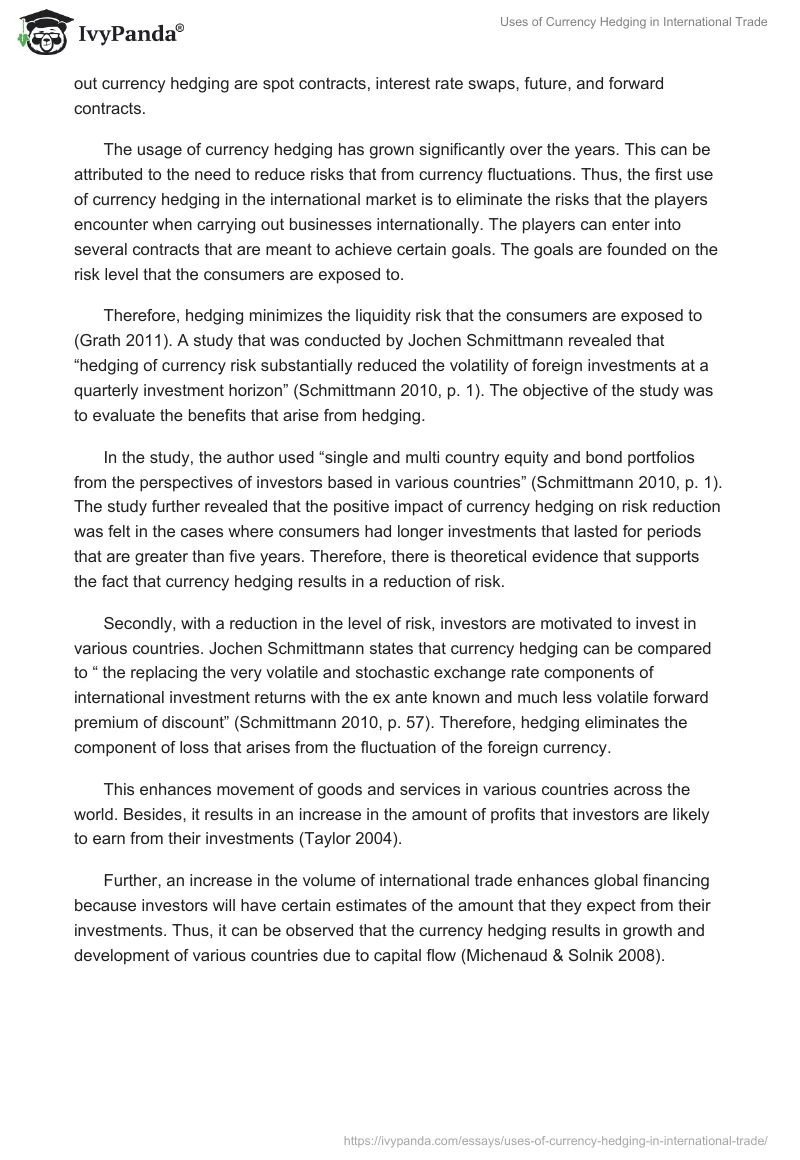Introduction
International trade generates several benefits to the countries and the players involved in the process. However, the fluctuations in the exchange rate between countries makes international trade quite risky. Statistics show that currency risk contributes about 40% of the total risks of international trade (Campbell, Medeiros & Viceira 2010).
Most players in the international market are of the opinion that the volatility of the exchange rate has a significant negative impact on trade across various countries. This belief has made government of various countries to come up with measures that reduces the negative impact of exchange rate fluctuations. An example is the European Monetary System (Chang 2009). The system makes use of one currency across Europe and this reduces the negative impact of foreign currency fluctuation.
Besides, a number of hedging instruments have been innovated to help reduce the risks that arise from currency fluctuation. The advancement of these products has resulted in a significant decline in the risks that arise from hedging (Reuvid & Sherlock 2011). This reflective treatise seeks to discuss the uses of currency hedging in international trade and the effect of currency hedging on young businesses who engage in international trade.
Uses of currency hedging in international trade
As a definition, “currency hedging is the act of entering into a financial contract in order to protect against unexpected, expected or anticipated changes in currency exchange rate” (Western Union Holdings Inc. 2013). Thus, currency hedging can be compared to how insurance policies work. Examples of the methods used in carrying out currency hedging are spot contracts, interest rate swaps, future, and forward contracts.
The usage of currency hedging has grown significantly over the years. This can be attributed to the need to reduce risks that from currency fluctuations. Thus, the first use of currency hedging in the international market is to eliminate the risks that the players encounter when carrying out businesses internationally. The players can enter into several contracts that are meant to achieve certain goals. The goals are founded on the risk level that the consumers are exposed to.
Therefore, hedging minimizes the liquidity risk that the consumers are exposed to (Grath 2011). A study that was conducted by Jochen Schmittmann revealed that “hedging of currency risk substantially reduced the volatility of foreign investments at a quarterly investment horizon” (Schmittmann 2010, p. 1). The objective of the study was to evaluate the benefits that arise from hedging.
In the study, the author used “single and multi country equity and bond portfolios from the perspectives of investors based in various countries” (Schmittmann 2010, p. 1). The study further revealed that the positive impact of currency hedging on risk reduction was felt in the cases where consumers had longer investments that lasted for periods that are greater than five years. Therefore, there is theoretical evidence that supports the fact that currency hedging results in a reduction of risk.
Secondly, with a reduction in the level of risk, investors are motivated to invest in various countries. Jochen Schmittmann states that currency hedging can be compared to “ the replacing the very volatile and stochastic exchange rate components of international investment returns with the ex ante known and much less volatile forward premium of discount” (Schmittmann 2010, p. 57). Therefore, hedging eliminates the component of loss that arises from the fluctuation of the foreign currency.
This enhances movement of goods and services in various countries across the world. Besides, it results in an increase in the amount of profits that investors are likely to earn from their investments (Taylor 2004).
Further, an increase in the volume of international trade enhances global financing because investors will have certain estimates of the amount that they expect from their investments. Thus, it can be observed that the currency hedging results in growth and development of various countries due to capital flow (Michenaud & Solnik 2008).
The effect of currency hedging on young businesses
Based on the above discussion it can be noted that hedging generates a number of benefits to various players in the market. Currency hedging is commonly used by large scale importers and exports (Branch 2010). Young businesses are often characterized by a low amount of capital and lack of financial base to cover all the risks that the company faces.
Besides, their exposure in the financial market is quite low. Thus, the cost of setting up and managing currency hedging outweighs the revenues and benefits that they expect to earn from the project. Therefore, most young businesses who engage in international trade do not use currency hedging.
However, the inconveniences and losses that the businesses incur are quite high. This calls for the need for the young business to use currency hedging. There are a number of effects of currency hedging on young businesses (Chincarini 2007). First, currency hedging protects the cash flows, margins and profitability of young businesses.
This arises from the fact that there will be a reduction in the amount of losses that arises from the risk of currency fluctuation. This eliminates the possibility of damage on the bottom line of the business. This effect is important because the young businesses do not have a strong capital base that will absorb losses of large magnitude (David & Stewart 2010).
Secondly, currency hedging enables the young businesses to budget effectively. The businesses are still facing a number of financial challenges in their operations. Therefore, accuracy in budgeting is essential because it helps such businesses to improve their operations. Thirdly, currency hedging gives room for the management to focus on other areas of the business that are of major concern and not the financial end of transactions (Walker 2008).
Therefore, with currency hedging, the management will not worry about the end result of transactions and this gives them time to focus on the growth of the business. Finally, currency hedging boasts the competitive advantage of young businesses. Statistics show that several young businesses do not know how to protect themselves from currency exposure or they do not engage in currency due to the amount of costs involved.
Therefore, if a business is in a position to eliminate the cost of exposure to currency risks in their books, then they will gain competitive advantage. This arises from the fact that the possible currency fluctuation losses that arise from a failure to hedge will be eliminated. Thus, they will be reported higher amount of profits (Akram, Rime & Sarno 2008).
Conclusion
The paper carried out a discussion on the use of currency hedging in international trade and the effect of currency hedging on young businesses who engage in international trade. The discussion above shows that the main use of currency hedging in international trade is to protect businesses from losses arising from currency fluctuation.
References
Akram, F, Rime, D & Sarno, L 2008, ‘Arbitrage in the foreign exchange market: turning on the microscope’, Journal of International Economics, vol. 76. no. 2, pp. 237-253.
Branch, A 2010, Export practice and management, Cengage Learning, USA.
Campbell, J, Medeiros, K & Viceira, L 2010, ‘Global currency hedging’, Journal of Finance, vol. 65. no. 1, pp. 87-121.
Chang, K 2009, ‘Currency hedging: a free lunch?’, MSCI Barra Research Insights. Web.
Chincarini, B 2007, ‘The effectiveness of global currency hedging after the Asian crisis’, Journal of Asset Management, vol. 8. no. 1, pp. 34-51.
David, P & Stewart, R 2010, International logistics: the management of international trade operations, Cengage Learning, USA.
Grath, A 2011, The handbook of international trade and finance: the complete guide to risk management, international payments and currency management, bonds and guarantees, credit insurance and trade finance, Kogan Page Publishers, USA.
Michenaud, S & Solnik, B 2008, ‘Applying regret theory to investment choices: currency hedging decisions’, Journal of International Money and Finance, vol. 27. no. 1, pp. 677-694.
Reuvid, J & Sherlock, J 2011, International trade: an essential guide to the principles and practice of export, Kogan Page Publishers, USA.
Schmittmann, J 2010, Currency hedging for international portfolios. Web.
Taylor, M 2004, ‘The purchasing power parity debate’, Journal of Economic Perspectives, vol. 18. no. 1, pp. 135-158.
Walker, E 2008, ‘Strategic currency hedging and global portfolio investments upside down’, Journal of Business Research, vol. 61. no. 2, pp. 657–668.
Western Union Holdings Inc. 2013, Currency hedging. Web.


